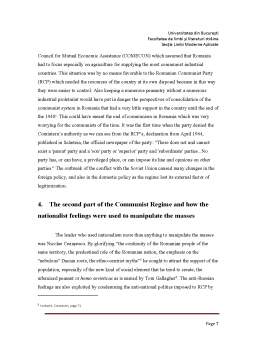Cuprins
- Introduction page 1
- 1. The beginnings of the nationalist feelings in Romania –
- The pre-war period page 2
- 2. The interwar period and the second part in the nationalism’s evolution page 3
- 3. Nationalism and Communism in Romania –
- The first part of the communist regime page 5
- 4. The second part of the Communist Regime and how the nationalist feelings were used to manipulate the masses page 7
- 5. The development of the Romanian-Hungarian relations –
- Causes and effects page 10
- 6. Romania after December 1989 page 13
- Conclusions page 15
- Bibliography page 18
- Table of contents page 19
Extras din referat
Introduction
The concept of Nationalism is the subject of one of the biggest controversies of the 20th century, if not the biggest of them all. Scholars have many definitions and many different ways of explaining nationalism and the way it appeared. It was also considered a closed subject at the end of ‘80s when the Eastern Europe states opened it again at the time that the communist regime, especially the USSR, collapsed. This debate is not the theme of my research, but it’s important to notice that nationalism represented in many countries a driving force for economical and social growth and, as well, it was used in political discourses for wining the power in state. In this pattern we can also include the case on which my study is based on: Romania in the communist period. For a better understanding of a Romanian nationalism I will analyze from a historical point of view, but the most important part of my work is presenting nationalism in the communist period and how it was used by the communist regime, and especially by Nicolae Ceausescu as a basis for the new external policy of independence from Moscow. I will also briefly analyze the Romanian-Hungarian relations that were continuously getting worse because of the situation of the Hungarian minority from Transylvania. The final part of my paper will describe the present situation of the Romanian nationalism and how and why the Romanian-Hungarian relations improved after the Romanian revolution.
It is very important to analyze the nationalism in Romania considering the historical periods because in each period it had different features and one period influences the other. I will try to explain in this research why the nationalism is still strong in Romania and, also, the relation between ethnies in Romania.
The nationalist tradition in the central and eastern Europe was built up by many factors: a long foreign domination, am interrupted process of state-building, national insecurity and conflicts, religious and ethnical grudges and resentments, national myths and a history of authoritarian rules.
1. The beginnings of the nationalist feelings in Romania – The pre-war period
Nationalism in Romania was the most pregnant in the interwar period, but it wasn’t a completely new phenomenon because the first nationalist feelings appeared at a time when Romania as a state didn’t even exist, the 18th century. At that time there were many separate, but geographically neighboring regions inhabited by Romanians: the Danubian Principalities of Wallachia and Moldavia, which have fallen under the ottoman control in the 15th century; Transylvania and the districts of Banat, Maramureş and Crişana which have been under the Hungarian rule. Also, there were Bukovina, the northern part of Moldavia and Bessarabia, the eastern part of Moldavia which was a part of the Russian empire. The Danubian principates were very similar regarding language and ethnicity and were the most fortunate regarding the expression of the national identity. Thus, in 1948 there were revolutions in all the principates inhabited by Romanians, but the one from Wallachia was the most successful. These revolutions were started by intellectuals, who were mostly young men who studied abroad, especially in France and were inspired by the French revolutionary and nationalist ideas. In Wallachia the revolution caused the instauration of a temporary government which was based on the new ideas of equality and rights. The government fell after 3 months, but its most important merit was that it produced a movement of the masses, especially of the lower class and implemented the new idea of the national unity. The exiled revolutionaries carried with them their beliefs and made them very popular among the Romanians from Transylvania, and also, among the intellectuals from the western countries who supported now the idea of unification of the Romanian principates. This dream was really materialized in 1859 when Alexandru-Ioan Cuza was elected in both Wallachia and Moldavia as a ruler, and so a part of the Romanians’ dream was accomplished: the formation of the Old Kingdom. Still, Transylvania was under Hungarian domination and it would take another 60 years for a new step in the state-building process to take place.
Preview document
Conținut arhivă zip
- The Romanian Nationalism.doc


























